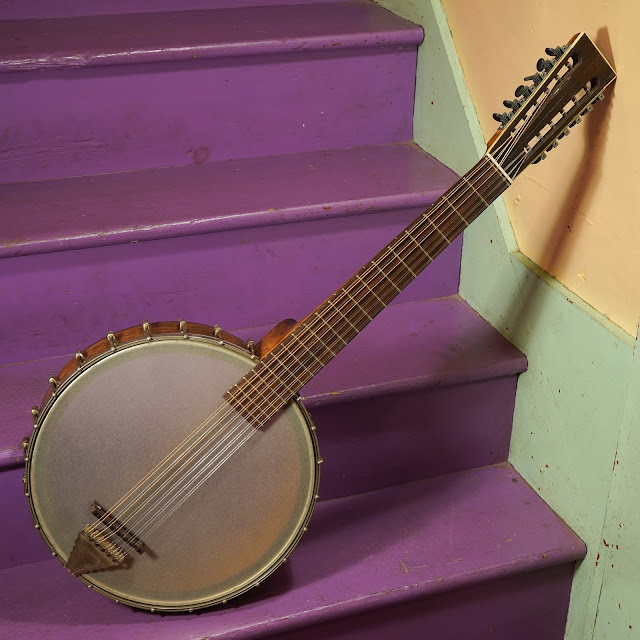1917 Edward Bardsley "Mascot" 12-String Banjo-Guitar
It's a 12-string banjo-guitar... from 1917. Just let that settle in. Imagine tuning this thing with its original skin head. Imagine playing it with an uncompensated bridge. Imagine... ow-ow-ow... no more, please!
My buddy Steve bought this ages ago and sent it up here to get sorted-out. It arrived with a mucked-up original head, a split heel, its fretboard falling-off and splintering, a set of awful original tuners on it, and need for... hope.
I got around to messaging the wonderful Bob Smakula, who I've been ordering banjo parts from more and more, and he ordered a custom Remo head to fit its 14-plus" rim. That took forever to get here but faster than I expected if you're at all used to Remo's speed at processing custom heads (they only do it once or twice a year). It also cost a bunch.
With head in hand and now installed on the rim, I was able to finish-off the rest of the work and get this thing up and running. I'd already fit a new 25 1/2" scale rosewood fretboard to the neck (with a radius) and fretted it with medium-gauge wire. I also repaired the damaged heel area (split from the original neck brace design), replaced some headstock binding, made a new fully-compensated adjustable bridge for it, rehung the '50s tailpiece, double-bolted the neck joint, and set it up. Because I had the convenience of a new fretboard, I gave it a zero fret nut, too.
What's the resulting instrument, though? Well, it's glorious and odd. It's fairly loud out front but kind-of quiet from behind. The ginormous neck takes some getting used to and the rim's large size makes it awkward until you bond with it a bit. It's not just "plug and play" for an average 12-string guitarist.
Tonewise, it sounds a bit like a cumbus (of the steel-string, banjo-bodied oud sort) but also mostly like a Leadbelly-style 12-string guitar. It's got thump, twang, and jingle-jangle all in one. It likes very-thin flatpicks or less-aggressive fingerpicking, though a "deft hand" with metal fingerpicks can get it to shine as well. It doesn't sound good at all if you're the "assaulting" kind of player.
I've got it strung with gauges like an electric 12-string guitar would have -- 20w/46w, 15/36w, 11/26w, 8/16, 12/12, 9/9 low to high. That also gives it more of a "banjo-style" tension on each string. Steve specified step-below tuning (DGCFAD low to high) but it tunes-up fine to E and also sounds great in open D and open Eb. The lowered tension of these light strings is key, by the way, because banjo heads don't sound best with a ton of tension on them. If they're over-strung they're actually "apparently" quieter and less responsive than otherwise because it's like the head is overdriven.
What else? It's got a birdseye maple neck and the original fretboard was ebonized maple. The new one (and its compatriot bridge) are rosewood. I didn't add any reinforcement to the neck because it's massive. The rim appears to be ply maple with a birdseye veneer on the outside and it's very deep and topped with a larger brass hoop tonering. The dowel is a big hunk of birdseye maple as well. The rim hardware, save the tailpiece, is mostly original save a few period replacements.
I removed the original neck brace device because it would only split the heel again if used, though I pictured it down the post and it was the key to identifying the maker of the instrument -- Edward Bardsley of Westville, New Jersey, whose patents for his neck hardware can be found online.
Repairs included: new fretboard and fretjob, heel repair, new repro-style tuners install, new adjustable/compensated bridge, new Remo Renaissance head install, replacement binding, seam repairs, modified construction/setup, replacement binding, various adjustments throughout...
Rim wood: maple
Tonering: hoop
Bridge: rosewood adjustable
Fretboard: rosewood
Neck wood: maple
Action height at 12th fret: 1/16" overall (adjustable, but fast)
String gauges: custom 46w-9 set
Neck shape: huge C/D
Board radius: ~9.5"
Neck relief: straight
Fret style: medium
Scale length: 25 1/2"
Nut width: 2"
Head diameter: 14 1/2" (custom Remo head, costly!)
Depth overall at rim: 3 7/8"
Weight: 7 lbs 14 oz
Condition notes: non-original head, fretboard, nut, tuners, and bridge. Rim hardware is all original. There's wear and tear to the finish everywhere with some bigger nicks and dings in the back of the neck (see pics) but the whole instrument is (now) sturdy and in good order. I finished work on this about a year ago (as of the update today, 6/13/22) and the instrument haas remained completely stable in service.





















Comments